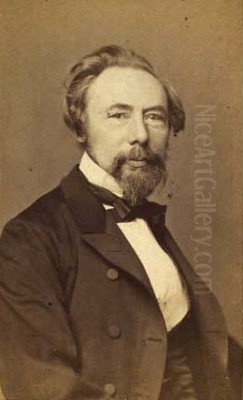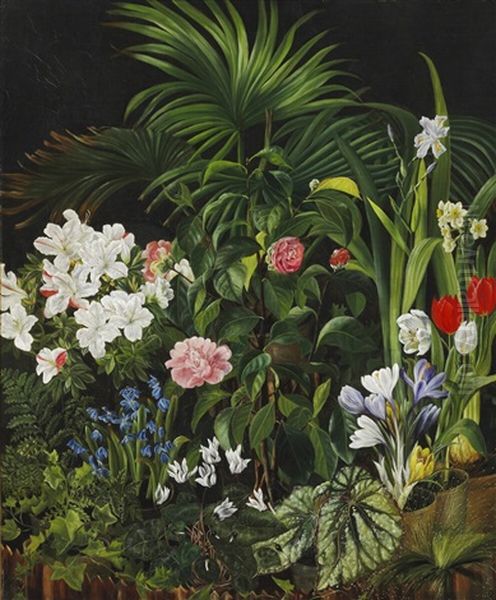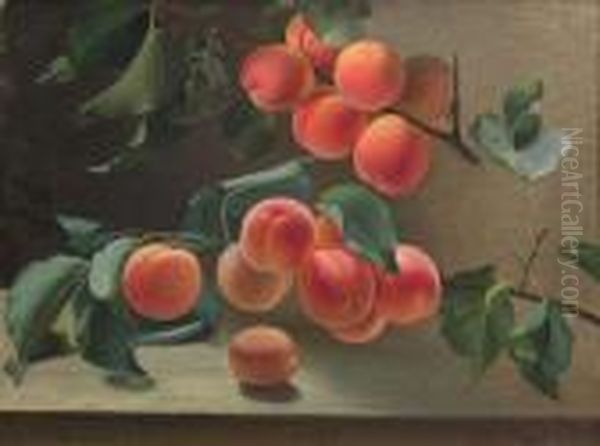
Carl Vilhelm Balsgaard stands as a significant, if sometimes overlooked, figure in the rich tapestry of 19th-century Danish art. Born in Copenhagen on December 29, 1812, and passing away in the same city in 1893, Balsgaard's artistic journey spanned a period of profound transformation in European and Danish art. He is primarily celebrated for his exquisite still life paintings, particularly of flowers and fruit, and his evocative landscapes, which often showcased a unique compositional structure and an innovative approach to perspective. His career was marked by academic dedication, royal patronage, and a quiet yet persistent contribution to the Danish art scene.
Early Life and Artistic Formation
Born into the bustling environment of early 19th-century Copenhagen, Carl Vilhelm Balsgaard's artistic inclinations led him to the prestigious Royal Danish Academy of Fine Arts. This institution was the crucible of Danish artistic talent, shaping generations of painters who would come to define what is now known as the Danish Golden Age and its subsequent developments. The Academy provided a rigorous, classical training, emphasizing drawing from life, anatomical studies, and the emulation of Old Masters.
A pivotal aspect of Balsgaard's education was his tutelage under Christoffer Wilhelm Eckersberg (1783-1853). Eckersberg is widely regarded as the "Father of Danish Painting" and was instrumental in steering Danish art towards a greater naturalism and a focus on direct observation of the Danish landscape and everyday life. His teaching philosophy stressed meticulous study from nature, precise rendering of light and shadow, and a strong understanding of perspective. This foundation undoubtedly left an indelible mark on Balsgaard's artistic development, instilling in him a respect for careful observation and technical proficiency.
While Eckersberg himself was renowned for his portraits, marine paintings, and Roman scenes, his emphasis on empirical study would have been applicable across genres. For a budding artist like Balsgaard, learning from such a luminary provided not only technical skills but also an entry into the prevailing artistic discourse of the time.
The Danish Golden Age: A Cultural Backdrop

To fully appreciate Balsgaard's work, it's essential to understand the artistic milieu in which he matured. The early to mid-19th century in Denmark is celebrated as the Danish Golden Age, a period of exceptional artistic and intellectual flourishing. This era saw painters like Christen Købke, Constantin Hansen, Wilhelm Bendz, Martinus Rørbye, and Jørgen Roed—many of them also students of Eckersberg—produce works characterized by a serene realism, intimate portrayals of Danish life, and luminous depictions of the local landscape.
While Balsgaard's primary period of activity extended beyond the traditional confines of the Golden Age (roughly 1800-1850), its ideals and the legacy of its masters, particularly Eckersberg, continued to resonate. The emphasis on national identity, the beauty of the ordinary, and the careful study of nature were principles that Balsgaard would carry forward, adapting them to his preferred genres of still life and landscape. The artistic environment was one of high standards and a shared pursuit of truth in representation.
Balsgaard's Artistic Journey: From Portraits to Profound Still Lifes
Balsgaard's early career saw him explore various genres, including portraiture and genre scenes, which were common paths for artists of his time. However, it was in the realm of still life painting that he truly found his voice and achieved lasting recognition. This shift indicates a deliberate artistic choice, perhaps a preference for the controlled environment of the studio where he could meticulously arrange his subjects and study the interplay of light, color, and texture at his own pace.
His still lifes are characterized by their detailed realism, vibrant yet harmonious color palettes, and often abundant compositions. He depicted a wide array of subjects within this genre: lush bouquets of flowers, arrangements of ripe fruit, and sometimes, more elaborate compositions incorporating game or seafood. These works were not mere imitations of nature but carefully constructed scenes designed to delight the eye and showcase the artist's skill.
The tradition of still life painting had a long and distinguished history in European art, particularly with Dutch Golden Age masters like Jan van Huysum or Rachel Ruysch, whose works were known for their incredible detail and illusionism. Balsgaard, while working in a later period, tapped into this tradition, bringing to it a 19th-century sensibility. His compositions often feel less overtly symbolic than some of their Baroque predecessors, focusing more on the aesthetic beauty and tangible reality of the objects themselves.
Mastery of Floral and Fruit Compositions

Balsgaard's floral paintings are a testament to his keen observational skills and his ability to capture the delicate beauty of individual blooms. He painted a variety of flowers, often in lush, overflowing arrangements that speak of nature's bounty. Works such as "Still life with spring flowers" (1880) or "Still life with flowers to glaïeuls" (1865) demonstrate his ability to render the specific textures of petals, the subtle gradations of color, and the overall vibrancy of a bouquet.
Similarly, his fruit pieces, like "Nature morte aux fruits" (1865) or "Nature morte aux pêches" (1865), showcase a remarkable talent for depicting the varied textures and sheens of different fruits. The velvety skin of a peach, the glossy surface of a grape, or the waxy peel of an apple are all rendered with convincing realism. He often combined fruits and flowers, creating rich, complex compositions that celebrate the abundance of the natural world. A prime example is the aptly titled "Fruit and Flowers," a recurring theme in his oeuvre, with specific dated versions highlighting his sustained interest.
One notable work, "Nature morte aux homards, fruits et fleurs" (1854), measuring an impressive 128 x 98 cm, combines the opulence of seafood with the freshness of fruit and flowers, demonstrating his ambition and skill in handling complex arrangements and diverse textures. Another significant piece, "Still life with flowers and fruit on a stone sill, with a river landscape in the background" (1865), is particularly interesting for its inclusion of a landscape element, adding depth and a broader context to the still life arrangement in the foreground.
Explorations in Landscape Painting
While best known for his still lifes, Carl Vilhelm Balsgaard was also an accomplished landscape painter. His landscapes often exhibit a unique approach to composition and perspective, setting them apart. He was not merely content with picturesque views but sought to convey a specific sense of place and atmosphere.
His travels, particularly to Italy, provided rich subject matter for his landscape work. The painting "The Church of Santa Croce in Gerusalemme with the Monastery, Rome" (c. 1872-1873) is a significant example from this period. This work was highly praised for its compositional structure and the originality of its viewpoint, suggesting that Balsgaard was actively engaging with the challenges of representing architectural and natural spaces in compelling ways. Such Italian scenes were popular among Northern European artists, following a tradition established by painters like Claude Lorrain and Nicolas Poussin, and continued by many 19th-century artists including contemporaries like Jean-Baptiste-Camille Corot.

Even in his native Denmark, he found inspiration. "København's gadescene, Vinter" (Copenhagen Street Scene, Winter), from the 1840s, shows his ability to capture the specific mood and light of a Danish urban environment in winter. This work aligns with the Danish Golden Age interest in depicting local scenes, though Balsgaard's treatment would have his own distinct touch.
Key Travels and European Influences
An artist's development is often shaped by exposure to different artistic traditions and environments. Balsgaard undertook several important study trips abroad, which undoubtedly broadened his artistic horizons. Around 1855, he visited Berlin, Dresden, and Paris. These cities were major artistic centers, each with renowned galleries and vibrant contemporary art scenes. In Berlin and Dresden, he would have encountered significant collections of Old Masters, including German Romantic painters like Caspar David Friedrich. Paris, already a hub of artistic innovation, would have exposed him to the burgeoning Realist movement, championed by artists like Gustave Courbet, and the lingering influence of Romanticism as seen in the works of Eugène Delacroix.
His later travels to Italy, around 1872-1873, were particularly significant for his landscape painting. Italy had long been a pilgrimage site for artists, drawn by its classical ruins, Renaissance masterpieces, and stunning natural beauty. Balsgaard's time there allowed him to study Italian art firsthand and to paint the distinctive Italian light and landscape, as evidenced by his Roman scenes. These experiences would have provided a counterpoint to his Danish training, enriching his palette and compositional strategies.
Academic Recognition and Royal Patronage
Balsgaard's talent and dedication did not go unnoticed within the Danish art establishment. In 1858, he achieved a significant milestone by becoming a member of the Copenhagen Academy of Fine Arts, the very institution where he had received his training. This membership was a mark of peer recognition and solidified his standing within the Danish art community.
A further honor came in 1864 when he was appointed curator of King Christian IX's private art collection. This prestigious position not only demonstrated the King's trust in Balsgaard's artistic judgment and connoisseurship but also provided him with intimate access to a significant collection of artworks. Such roles often involved advising on acquisitions, conservation, and display, further deepening the artist's engagement with art history and contemporary practice.

Concurrent with this appointment, from 1864 to 1871, Balsgaard also served as an art teacher to Queen Louise. Royal tutelage was a mark of high esteem and provided a stable form of patronage. This connection to the Danish royal family underscores his respected position in the cultural life of the nation.
Balsgaard and His Contemporaries
Carl Vilhelm Balsgaard operated within a dynamic Danish art scene. The Charlottenborg Exhibition, held at Charlottenborg Palace (the home of the Royal Danish Academy of Fine Arts), was the premier venue for contemporary artists to showcase their work. Balsgaard regularly exhibited here, and records show his works, such as fruit and flower pieces, being displayed in exhibitions like the one in 1865. These exhibitions were crucial for artists to gain visibility, attract patrons, and engage in dialogue with their peers.
His contemporaries at these exhibitions would have included a wide range of Danish artists, from established figures to emerging talents. Landscape painters like P.C. Skovgaard and Johan Thomas Lundbye, who were key figures in National Romantic landscape painting, would have been exhibiting, as would genre painters like Wilhelm Marstrand. While direct records of Balsgaard's specific interactions with every contemporary might be scarce, his participation in such a central institution implies a professional engagement with the broader artistic community.
His role as a student of Eckersberg also places him in a lineage that includes many of the most celebrated names of the Danish Golden Age. Though his career extended into a later period, the foundational principles learned from Eckersberg would have provided a common language with other artists who shared that training.
Signature Works and Artistic Style Revisited
Balsgaard's artistic style is characterized by a meticulous attention to detail, a refined sense of color, and strong compositional skills. In his still lifes, he demonstrated an almost scientific precision in rendering the textures and forms of flowers, fruits, and other objects. Yet, this realism was always coupled with an artistic sensibility that arranged these elements into harmonious and visually pleasing wholes.
His "Still life with fruit and flowers" (1865, 76.5 x 62 cm) is a quintessential example. Such works typically feature a carefully balanced arrangement, with light used to highlight the central elements and create a sense of depth. The colors are rich but not garish, and there's a palpable sense of the different textures – the softness of petals, the sheen of fruit, the coolness of a stone ledge.
The "Gloriosa superba" (undated, 24.5 x 32 cm), though smaller, would have focused on the specific botanical accuracy and beauty of this particular flower, a common practice in detailed floral studies. His ability to capture the individual character of each plant or fruit was a hallmark of his still life practice.
In landscapes like "The Church of Santa Croce in Gerusalemme, Rome," his skill in perspective and his ability to capture architectural detail within a broader atmospheric setting are evident. The "unique构图结构 (compositional structure)" and "新颖的视角 (novel perspective)" noted by critics suggest an artist who was not content with formulaic representations but sought to find fresh ways of seeing and depicting his subjects.
The Enduring Legacy of Carl Vilhelm Balsgaard
Carl Vilhelm Balsgaard's legacy lies primarily in his contribution to Danish still life painting. In an era where grand historical narratives or romantic landscapes often took center stage, Balsgaard championed the quieter, more intimate genre of still life, elevating it with his technical skill and artistic vision. His works are a testament to the beauty that can be found in the careful observation of everyday objects and the natural world.
His role as a member of the Academy, curator to the King, and teacher to the Queen also indicates his significance within the cultural infrastructure of 19th-century Denmark. He was not an isolated artist but an active participant in the artistic life of his time, contributing to the preservation and appreciation of art, as well as its creation.
While perhaps not as widely known internationally as some of his Danish Golden Age predecessors like Købke or Eckersberg himself, or later figures like Vilhelm Hammershøi, Balsgaard holds a secure place in Danish art history. His paintings continue to be appreciated for their beauty, craftsmanship, and the window they offer into the artistic sensibilities of his time. His dedication to his craft and his ability to imbue his subjects with a quiet dignity ensure his continued relevance.
His works can be found in Danish collections and occasionally appear at auction, reminding contemporary audiences of his skill. For students of 19th-century European art, and particularly Danish art, Balsgaard offers an example of an artist who excelled in his chosen genres, contributing to the rich artistic heritage of his nation. He successfully navigated the transition from the Golden Age's peak into the later 19th century, adapting to changing tastes while maintaining a commitment to quality and careful observation that was the hallmark of his training.
In conclusion, Carl Vilhelm Balsgaard was a dedicated and highly skilled Danish painter whose contributions, especially in the realm of still life, deserve recognition. His meticulous technique, his eye for color and composition, and his ability to capture the essence of his subjects mark him as a significant artist of his era. From his academic beginnings under the tutelage of C.W. Eckersberg to his respected position within the Danish art establishment and royal circles, Balsgaard's life and work reflect a deep commitment to the pursuit of artistic excellence.